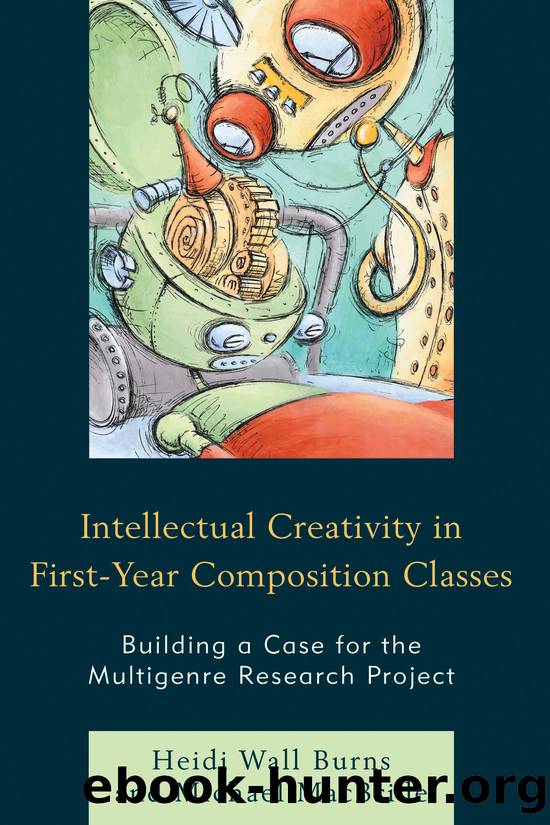Intellectual Creativity in First-Year Composition Classes by Burns Heidi Wall;MacBride Michael; & Michael MacBride

Author:Burns, Heidi Wall;MacBride, Michael; & Michael MacBride
Language: eng
Format: epub
Publisher: Rowman & Littlefield Publishers
Chapter 4
Plug-In Activities
INTRODUCTION
One of the exciting things about the multigenre research project (MGRP) is the diversity of work that students are producing. One of the challenges is that when you have twenty-five students working on different projects and topics, it can be hard to find in-class activities that are relevant to everyone. Not every student project will require a short story, poem, graph, or other specific genre.
One of the broader goals of the MGRP is to expose students to different genres and to explore the rhetorical choices that accompany different genres. Because students will encounter any number of types of writing in their futures (graduate school, workplace, etc.), exposing students to a wide variety of genres is in their best interest. Additionally, and more directly applicable to their work in class, by examining numerous forms, identifying the grammar or rules of those forms, and working within those constraints, students will become more aware of the rules, restrictions, and freedoms allowed within their preferred genres. It is with these ideas in mind that the activities in this chapter are constructed.
What follows this short introduction are in-class activities that the authors have found particularly effective in the classroom. The discussions that ensue after completing the activities are productive and have helped students to think critically of the variety of genres available to them, why and when they may use them, and how to better navigate this type of writing when they encounter it (whether it be in a textbook, an academic journal, the workplace, etc.). These activities are not all inclusive. They should be used as a launching point for the activities that best fit the tenor of your specific classroom.
As a general rule, any text could be used in a classroom activity. We have used a variety of fiction, nonfiction, essays, former student work (with permission), newspapers, letters, recipes, photographs, and maps. The important thing to remember when using such texts is that the text itself is not as important as the form is and what students can learn from it. This involves asking questions directly relevant to the projects that students are creating. What are the bare essentials of this form? How does it differ from other genres that fall under the bigger umbrella of âliteratureâ? What rhetorical choices did the author have to make for this form to be effective? How is the message more effectively conveyed through this form than, say, poetry or an essay? In some cases, it might be important to discuss the overall theme of a text, but the caution is to stay focused on the form and not allow the content to become the focus of the lesson.
There is always a danger when teachers provide students with examples, or break down complicated tasks into simple steps, that students will simply latch onto that example (or process) to produce their own work. It is essential to remind students that just because they like a particular form or genre, it does not mean that that genre will fit within the confines of their project.
Download
This site does not store any files on its server. We only index and link to content provided by other sites. Please contact the content providers to delete copyright contents if any and email us, we'll remove relevant links or contents immediately.
| Arts & Humanities | Health |
| Language Arts | Library Skills |
| Mathematics | Reading & Phonics |
| Science & Technology | Social Studies |
The Art of Coaching Workbook by Elena Aguilar(50045)
Trainspotting by Irvine Welsh(20948)
Twilight of the Idols With the Antichrist and Ecce Homo by Friedrich Nietzsche(18268)
Fangirl by Rainbow Rowell(8760)
Periodization Training for Sports by Tudor Bompa(7892)
Change Your Questions, Change Your Life by Marilee Adams(7324)
This Is How You Lose Her by Junot Diaz(6404)
Asking the Right Questions: A Guide to Critical Thinking by M. Neil Browne & Stuart M. Keeley(5322)
Grit by Angela Duckworth(5266)
Red Sparrow by Jason Matthews(5170)
Paper Towns by Green John(4757)
Room 212 by Kate Stewart(4707)
Ken Follett - World without end by Ken Follett(4415)
The Sports Rules Book by Human Kinetics(4048)
Housekeeping by Marilynne Robinson(4021)
Double Down (Diary of a Wimpy Kid Book 11) by Jeff Kinney(3879)
Papillon (English) by Henri Charrière(3875)
The Motorcycle Diaries by Ernesto Che Guevara(3757)
Exercise Technique Manual for Resistance Training by National Strength & Conditioning Association(3757)
